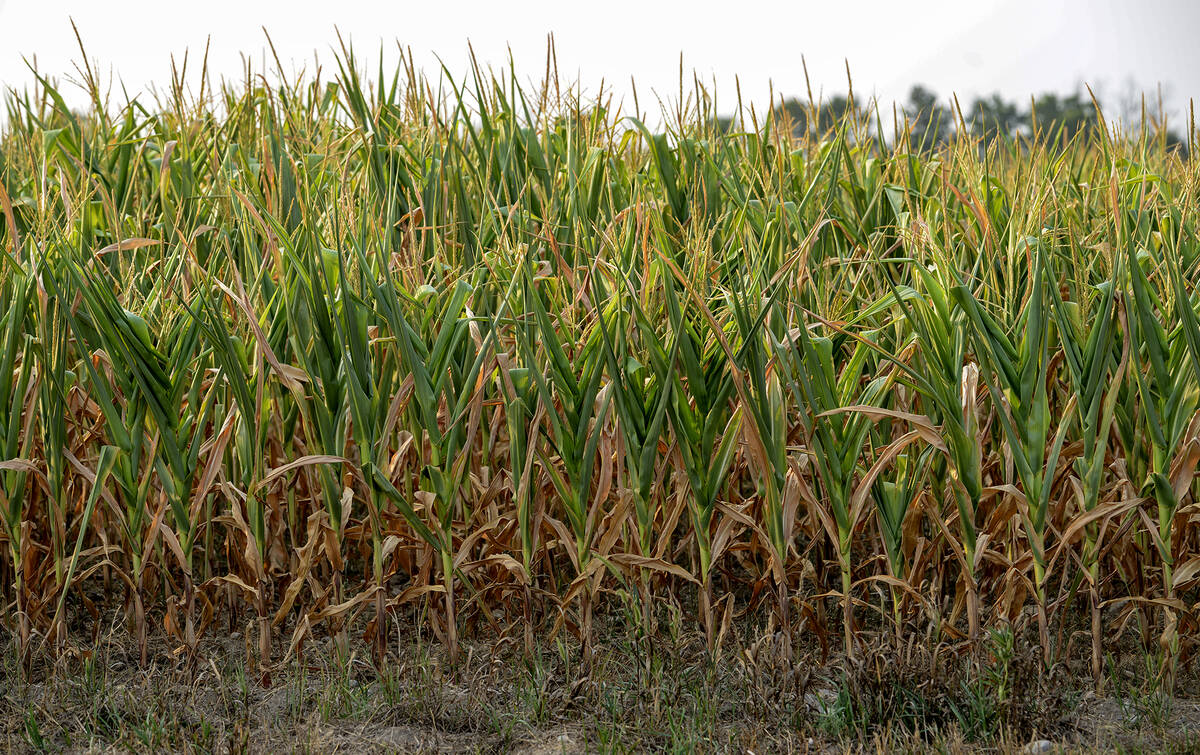Ontario wheat, corn and soybean prices dropped 30 to 50 cents a bushel throughout January. Commercial grain companies in Ontario are holding larger stocks of the three main crops and have sufficient supplies to satisfy their nearby demand. At the same time, export demand moves through a seasonal low from January through March. The freeze of the lakes system usually results in basis deterioration. These two factors cause the price spreads between February and May to widen.
Quick look
Soybeans: Ontario export sales will struggle given the sharp discount of Brazilian origin to Ontario and U.S. prices.
Corn: The USDA’s final crop survey was a surprise, increasing U.S. corn yield to 177.3 bu./acre.
Wheat: Both U.S. and northern European winter wheat production will be less than 2023.
Ontario winter wheat remains vulnerable and there is potential for a larger portion of winterkill this spring. There are pockets with limited snow cover. Temperatures were extremely cold in mid-January after lawn-cutting temperatures over the Christmas season.
Read Also

Extreme variability marks Ontario’s 2025 corn crop
The yield potential of Ontario’s 2025 corn crop was lost in some areas due to extreme dry conditions.
The USDA released its final production estimates for the 2023 U.S. corn and soybean crops. Corn production was higher than expected due to record yields. Soybean yields were also up from previous forecasts. These bearish fundamentals have pressured world values.
The Brazilian soybean and first-crop corn harvests are in the early stages. The bulk of the Argentine corn crop is in the grain-filling stage and full-season soybeans are setting and filling pods. Brazilian corn and soybean production will be down from last year but Argentina is on track for record output for the row crops.
U.S. hard red winter wheat acres are expected to be down 9.2 per cent from last year,red winter acres will be down six per cent. This fresh USDA data comes on the heels of lower German and French winter acres. SovEcon expects Russian wheat output to be similar to last year after above-normal precipitation over the winter.
We have a neutral outlook for the Canadian dollar. U.S. economic growth has been stronger than expected while the Canadian economy will likely contract in the first half of 2024. Weaker consumer demand in Canada will likely result in lower inflationary data through 2024 and the Bank of Canada will likely be inclined to lower its benchmark rate in the summer.
Energy prices have decreased in Canada but the global oil market remains vulnerable to escalating military activity in the Red Sea. The Russian and Ukraine conflict will intensify in the spring after a sleepy winter. Outside influences are expected to enhance Ontario corn and soybean prices in late spring and summer.
Soybeans
Earlier in winter, export demand for soybeans was stronger than buying interest from domestic crushers. However, weaker offshore movement in January and February caused bids for export movement to drop below prices from local crushers. At the same time, farmer selling has been sufficient to keep commercial supplies at comfortable levels to satisfy nearby domestic and export demand. Looking forward, on-farm and commercial supplies will drop to tighter levels during the late spring and summer. Domestic crusher bids will move to premium over offshore values from May through July in an effort to attract soybean imports from south of the border.
The USDA’s final production survey for 2023 had soybean production at 113.4 million tonnes, up one million from the previous estimate but down 2.9 million from last year. The increase in production went straight to the carryout as there was no change to the demand forecasts. The 2023/24 ending stocks are now estimated at 7.6 million tonnes, up from 7.2 million tonnes last year. U.S. exports for 2023/24 are projected at 47.7 million tonnes, down from 54.2 million last year.
During the final week of January, U.S. soybeans f.o.b. the Gulf were quoted at US$476/tonne, down US$31/tonne from 30 days earlier. Ontario soybeans were offered at US$470/tonne f.o.b. St. Lawrence. Brazilian soybeans were offered at US$419/tonne f.o.b. Paranagua. This was down from US$85/tonne from the last week of December.
U.S. and Ontario export sales will struggle given the sharp discount of Brazilian origin to Ontario and U.S. prices. Argentine soybeans were offered at US$457/tonne but we expect more price pressure later in summer.
On the January WASDE report, Brazilian soybean production was estimated at 157 million tonnes, down from last year’s output of 116.2 million. This is still a big number and we will likely see a building of ending stocks in Brazil. The Argentine crop was estimated at 50 million tonnes, doubling last year’s number of 25 million. This is extremely bearish for meal and vegetable oil prices as Argentina returns to the world market as a major exporter.
What to do: At this time, we’re advising producers to sell an additional 10 per cent of their 2023 production, bringing total sales to 60 per cent. It will be easy for Ontario crushers to attract U.S. imports in the summer given the weaker world market. We’re anticipating a five per cent year-over-year increase in U.S. soybean acres this spring. The fundamentals point to lower prices. We need to increase sales now that South American production is more certain.
Corn
We’re expecting Ontario corn stocks in commercial positions as of Dec. 31 to come in at 4.1 million tonnes, unchanged from last year. On-farm stocks are estimated at 3.6 million tonnes, down from 4.3 million. Grain companies have sufficient supplies to cover nearby domestic and export demand through February and March. During April and May, the Ontario market needs to trade higher in an effort to attract farmer selling. Ontario corn exports move through a seasonal low during the winter and will increase later in spring. This will be the main factor influencing the domestic prices.
Our forecast has Ontario corn exports from Jan. 1 through March 31 at 1.5 million tonnes. From April 1 through July 31, Ontario corn exports are expected to reach 4.5 million tonnes. Exports will taper off during August. The larger export pace is due to stronger demand from Northern Europe. The larger export program will result in historically tight on-farm corn stocks as of Aug. 31, 2024.
The USDA’s final crop survey had the U.S. corn yield at 177.3 bu./acre, up from the previous estimate of 174.9 bu./acre. This was a surprise to the industry. USDA’s final production number came in at 389.7 million tonnes, up from the 2022 crop size of 346.7 million tonnes and up from the five-year average of 365 million tonnes.
During the last week of January, U.S. corn offers out of the Gulf were quoted at US$203/tonne f.o.b. while Brazilian corn was offered at US$222/tonne f.o.b. Argentine corn was valued at US$205/tonne f.o.b.
The Argentine corn crop is expected to finish at 55 million tonnes, up from last year’s output of 34 million tonnes. The bulk of the Argentine corn harvest will be in March and first half April. Brazil’s first corn crop will be harvested in February and is estimated at 20 million tonnes. The second crop, which will be harvested in late June and July, is estimated at 90.5 million tonnes. Trade estimates have total Brazilian production in the range of 110-115 million tonnes, down from last year’s record of 137 million.
The market is in a unique situation. Low prices discourage production and encourage demand. U.S. export sales are running 35 per cent above year-ago levels. At the same time, we could see a four- to 5.5-million year-over-year decline in U.S. corn acres this spring. The corn market will be extremely sensitive to weather developments during spring and summer.
What to do: This week, we’re advising farmers to sell 10 per cent of their 2023 corn production, bringing total sales to 50 per cent. Given the lower U.S. production prospects in 2024, we’re looking for stronger prices later in spring and summer. The market cannot afford a crop problem in the U.S.
Wheat
The Ontario wheat market is functioning to encourage demand due to the larger 2023 production. Domestic millers are well covered through spring. Ontario elevator bids depend on export demand.
At the time of writing this article in late January, Russian wheat was quoted at US$245/tonne f.o.b. Black Sea while French wheat was valued at US$239/tonne f.o.b. Rouen. U.S. soft red winter wheat was quoted at US$250/tonne f.o.b. the Gulf. Ontario soft red winter was quoted at US$230/tonne f.o.b. St. Lawrence.
We’re expecting the aggressive export pace from Russia to subside in the latter half of the crop year. Through January, Russian exports were estimated at 30 million out of a total of 50 million tonnes. At this stage, the Russian 2024 wheat crop is estimated at 89-92 million tonnes, similar to the 2023 output of 91 million tonnes (USDA).
Russia backed out of the Turkish UN-brokered grain deal in July 2023. Ideas were that Ukraine wheat exports would grind to a halt. This hasn’t been the case. Ukrainian wheat exports out of Danube infrastructure along with the Ukraine’s own export sea corridor have resulted in a year-over-year increase in grain/wheat exports. Ukraine wheat production for 2024 is estimated at 25 million tonnes, up from the 2023 crop size of 23.4 million.
The USDA released its Winter Wheat Acreage Report on Jan. 12, 2024. U.S. hard red winter wheat acres came in at 24 million, down from 25.5 million acres last year. Using a traditional abandonment rate and five-year average yield, production has potential to reach 19.4 million tonnes, up from the 2023 output of 15.9 million tonnes and up from the five-year average of 18.7 million tonnes.
U.S. soft red winter wheat area was 6.86 million acres. U.S. soft red winter production has potential to finish near 10.8 million tonnes, down from the 2023 crop of 12.2 million tonnes but still up from the five-year average of 8.1 million tonnes.
France and Germany have decreased their winter wheat acres by eight to 10 per cent from last year. Total European wheat production for 2024 is estimated at 120-124 million tonnes, down from the 2023 crop size of 134 million tonnes.
There are no real fireworks occurring in the wheat market. Our strategy is to sell regular increments throughout the crop year.
What to do: We’ve advised producers to be 60 per cent sold on their wheat. The winter wheat markets tend to incorporate a risk premium when the U.S. winter wheat comes out of dormancy. We’re waiting for this seasonal rally at which time we will make our next recommendation.













